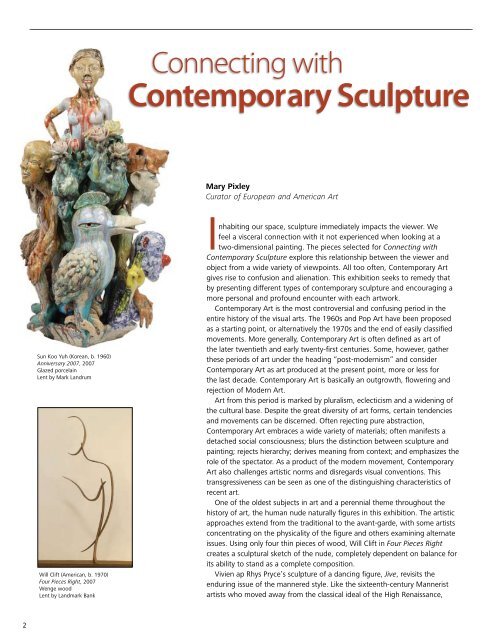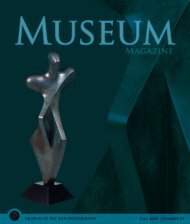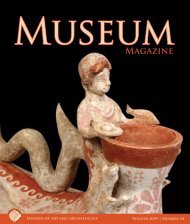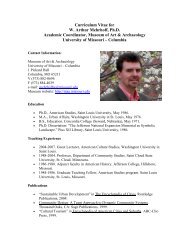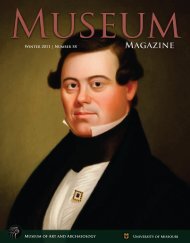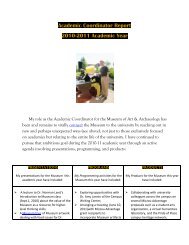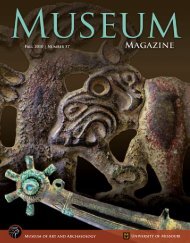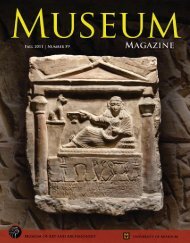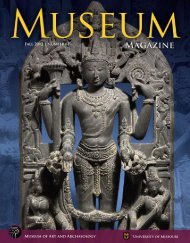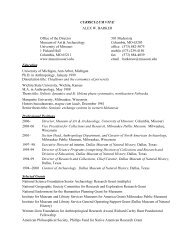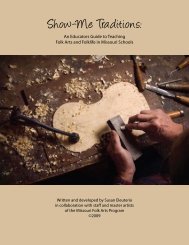Winter 2010 - Museum of Art and Archaeology - University of Missouri
Winter 2010 - Museum of Art and Archaeology - University of Missouri
Winter 2010 - Museum of Art and Archaeology - University of Missouri
Create successful ePaper yourself
Turn your PDF publications into a flip-book with our unique Google optimized e-Paper software.
Connecting with<br />
Contemporary Sculpture<br />
Mary Pixley<br />
Curator <strong>of</strong> European <strong>and</strong> American <strong>Art</strong><br />
Sun Koo Yuh (Korean, b. 1960)<br />
Anniversary 2007, 2007<br />
Glazed porcelain<br />
Lent by Mark L<strong>and</strong>rum<br />
Will Clift (American, b. 1970)<br />
Four Pieces Right, 2007<br />
Wenge wood<br />
Lent by L<strong>and</strong>mark Bank<br />
Inhabiting our space, sculpture immediately impacts the viewer. We<br />
feel a visceral connection with it not experienced when looking at a<br />
two-dimensional painting. The pieces selected for Connecting with<br />
Contemporary Sculpture explore this relationship between the viewer <strong>and</strong><br />
object from a wide variety <strong>of</strong> viewpoints. All too <strong>of</strong>ten, Contemporary <strong>Art</strong><br />
gives rise to confusion <strong>and</strong> alienation. This exhibition seeks to remedy that<br />
by presenting different types <strong>of</strong> contemporary sculpture <strong>and</strong> encouraging a<br />
more personal <strong>and</strong> pr<strong>of</strong>ound encounter with each artwork.<br />
Contemporary <strong>Art</strong> is the most controversial <strong>and</strong> confusing period in the<br />
entire history <strong>of</strong> the visual arts. The 1960s <strong>and</strong> Pop <strong>Art</strong> have been proposed<br />
as a starting point, or alternatively the 1970s <strong>and</strong> the end <strong>of</strong> easily classified<br />
movements. More generally, Contemporary <strong>Art</strong> is <strong>of</strong>ten defined as art <strong>of</strong><br />
the later twentieth <strong>and</strong> early twenty-first centuries. Some, however, gather<br />
these periods <strong>of</strong> art under the heading “post-modernism” <strong>and</strong> consider<br />
Contemporary <strong>Art</strong> as art produced at the present point, more or less for<br />
the last decade. Contemporary <strong>Art</strong> is basically an outgrowth, flowering <strong>and</strong><br />
rejection <strong>of</strong> Modern <strong>Art</strong>.<br />
<strong>Art</strong> from this period is marked by pluralism, eclecticism <strong>and</strong> a widening <strong>of</strong><br />
the cultural base. Despite the great diversity <strong>of</strong> art forms, certain tendencies<br />
<strong>and</strong> movements can be discerned. Often rejecting pure abstraction,<br />
Contemporary <strong>Art</strong> embraces a wide variety <strong>of</strong> materials; <strong>of</strong>ten manifests a<br />
detached social consciousness; blurs the distinction between sculpture <strong>and</strong><br />
painting; rejects hierarchy; derives meaning from context; <strong>and</strong> emphasizes the<br />
role <strong>of</strong> the spectator. As a product <strong>of</strong> the modern movement, Contemporary<br />
<strong>Art</strong> also challenges artistic norms <strong>and</strong> disregards visual conventions. This<br />
transgressiveness can be seen as one <strong>of</strong> the distinguishing characteristics <strong>of</strong><br />
recent art.<br />
One <strong>of</strong> the oldest subjects in art <strong>and</strong> a perennial theme throughout the<br />
history <strong>of</strong> art, the human nude naturally figures in this exhibition. The artistic<br />
approaches extend from the traditional to the avant-garde, with some artists<br />
concentrating on the physicality <strong>of</strong> the figure <strong>and</strong> others examining alternate<br />
issues. Using only four thin pieces <strong>of</strong> wood, Will Clift in Four Pieces Right<br />
creates a sculptural sketch <strong>of</strong> the nude, completely dependent on balance for<br />
its ability to st<strong>and</strong> as a complete composition.<br />
Vivien ap Rhys Pryce’s sculpture <strong>of</strong> a dancing figure, Jive, revisits the<br />
enduring issue <strong>of</strong> the mannered style. Like the sixteenth-century Mannerist<br />
artists who moved away from the classical ideal <strong>of</strong> the High Renaissance,<br />
2


